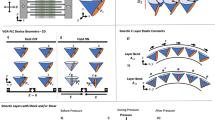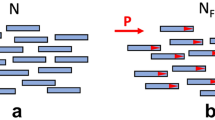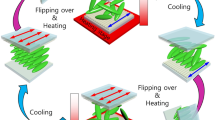Abstract
The switching properties of most liquid-crystal electro-optic devices rely mainly on the reorientation of the average molecular direction (director) within the bulk of the liquid-crystal layer1. Reorientation of the director at or near the surfaces of the layer usually has an insignificant effect on device performance. Here we describe a different configuration in which a nematic liquid crystal is placed between a flat surface treated to induce a parallel anchoring of the director and a grating surface treated to give a perpendicular anchoring. We show that this configuration leads to an effective azimuthal anchoring at the grating surface that depends on the applied voltage when the nematic phase has negative dielectric anisotropy (that is, the director has a tendency to align perpendicular to the applied field). This leads to a voltage-controlled twist effect in the liquid-crystal cell that is highly sensitive to the grating profile. Furthermore, this twist effect possesses an electro-optic response which is far less dependent on viewing angle compared to many other liquid-crystal display configurations. We therefore suggest that this technology might find application in the next generation of liquid-crystal displays.
This is a preview of subscription content, access via your institution
Access options
Subscribe to this journal
Receive 51 print issues and online access
$199.00 per year
only $3.90 per issue
Buy this article
- Purchase on Springer Link
- Instant access to full article PDF
Prices may be subject to local taxes which are calculated during checkout




Similar content being viewed by others
References
Shanks, I. A. The physics and display applications of liquid crystals. Contemp. Phys. 23, 65–91 (1982).
Cognard, J. Alignment of nematic liquid crystals in their mixtures. Mol. Cryst. Liq. Cryst. (Suppl. Ser.) A 5, 1–77 (1982).
Geary, J. M., Goodby, J. W., Kmetz, A. R. & Patel, J. S. The mechanism of polymer alignment of liquid crystal materials. J. Appl. Phys. 62, 4100–4108 (1987).
Schadt, M., Seiberle, H. & Schuster, A. Optical patterning of multidomain liquid-crystal displays with wide viewing angles. Nature 381, 212–215 (1996).
Berreman, D. W. Alignment of liquid crystals by grooved surfaces. Mol. Cryst. Liq. Cryst. 23, 215–231 (1973).
Masahito, O. & Kondo, K. The in-plane switching of homogeneously aligned nematic liquid crystals. Liq. Cryst. 22, 379–390 (1997).
Acknowledgements
We thank A. Smout for AFM measurements.
Author information
Authors and Affiliations
Corresponding author
Rights and permissions
About this article
Cite this article
Bryan-Brown, G., Brown, C., Sage, I. et al. Voltage-dependent anchoring of a nematic liquid crystal on a grating surface. Nature 392, 365–367 (1998). https://doi.org/10.1038/32849
Received:
Accepted:
Issue Date:
DOI: https://doi.org/10.1038/32849
This article is cited by
-
Out of the groove
Nature (1998)
Comments
By submitting a comment you agree to abide by our Terms and Community Guidelines. If you find something abusive or that does not comply with our terms or guidelines please flag it as inappropriate.



